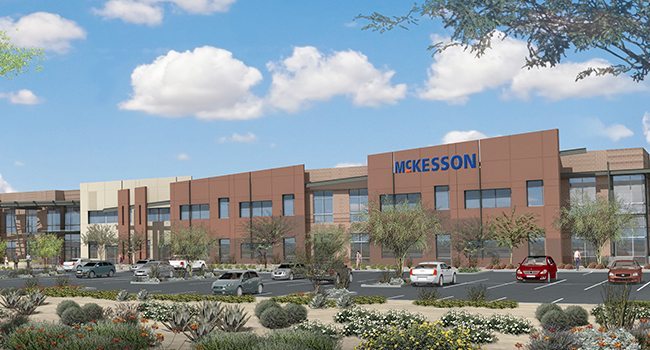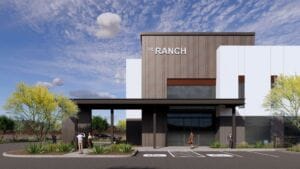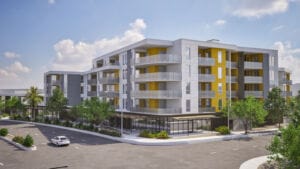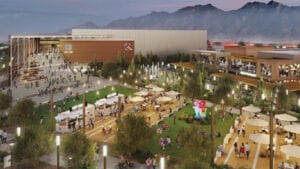From the growing prevalence of collaborative open workspaces and shifting demands of a multi-generational workforce to disruptive new technologies and an increased emphasis on facilitating health and wellness within the workplace, building owners and property managers are doing their best to adjust as market demands shift.
The Building Owners and Managers Association (BOMA) of Greater Phoenix strives to be an industry leader for best practices, innovative programs and groundbreaking initiatives through education and advocacy.
Thus, a group of local BOMA members from different backgrounds, companies and disciplines were asked to explain how the latest shifts in the market might impact your business or role as a tenant.
AZRE: What’s one big trend that’s catching your attention?
Tom Hatch: Collaborative workspace is one trend continuing to drive change in office space. Nearly every tenant improvement shows firms moving away from private offices and high cubical walls as workspace is becoming increasingly open and free form. Additionally, as headcount increases in traditional office space, parking becomes a bigger issue for tenants, employees and visitors.

Tawnya Peirce: While most landlords quickly reinstated staple Class A services and tenant amenities once the market recovered, best-in-class amenities and tenant touch points that previously only catered to C-suite executives are now being considered for all types of office environments. Sophisticated parking access controls and common-area mood elements such as music, scents and high-end toiletries are just a few features that are more common today than ever, and without them, spaces feel underserviced.
Joanna Freeman: Technology because it is permeating the property management world. Tenants and their employees are rejecting anything old school. They want high tech from the design aesthetic of their space to the smart technologies in their lobbies to the way we communicate about the day-to-day operation of their buildings. They want electronic directories – not static boards. They want interior office spaces that connect versus divide. And they want any technology that allows them to work and play and communicate on the fly.
Becky Bishop: Resilience. First it was green buildings, then it was sustainable buildings and now it is also resilient buildings. This has come into focus because of the extreme weather changes the country is experiencing. Resilience is focusing on making sure that your building can survive severe weather such as flooding, tornados, hail or dust storms.
Robert Vincent: Definitely the industrial product and markets. It used to be that industrial buildings were old and outdated and in undesirable submarkets. It’s been great to see the facelift of this product has been refreshed to new, sexy, efficient buildings that top Fortune companies are looking for to build their business and portfolios.
Dave Dickens: A big trend we’re seeing is an increased need to be more knowledgeable about energy management systems (or controls) for their mechanical systems. Putting in a new controls strategy gives a property immediate asset value, which can greatly improve the ability to rent or possibly sell the property for more. IMCOR offers full controls solution with an open protocol system, so our customers have the flexibility to use anyone, as opposed to only proprietary options.
AZRE: Looking ahead, what’s another potential trend worth keeping an eye on?
Robert Vincent: I think the storage product is the silent trend out there. With populations growing, low maintenance for operations, and being somewhat recession proof, I can see this becoming a new trend.
Tom Hatch: Ridesharing and self-driving cars are projected to have a big impact on a number of business sectors including real estate. The emergence of autonomous cars and ridesharing has the potential to drastically reduce the need for employee and visitor parking in addition to the amount of space required for roads. As municipalities adopt zoning requirements that reflect these changes, property owners could be left with significant tracts of land historically dedicated to traffic and parking available for redevelopment and/or repurpose.

Becky Bishop: The WELL Building Standard. It was developed to keep the occupants of a building healthy and productive. It focuses on seven core concepts: light, air, comfort, fitness, water, nourishment and mind. For example, the Air Concept focuses on air quality, which can be improved by indoor vegetation to produce an oxygen rich environment. Other practices would be using the right cleaning products, changing air filters frequently and using low VOC producing paint.
Dave Dickens: More and more at IMCOR, we’re seeing our customers, who are both owners and managers, being asked to know even more about their mechanical systems and controls strategies. They’re being asked what can they do to run their buildings more efficiently, and how they can decrease or increase spending to provide a higher ROI. More frequently, owners want us to help justify their spending with either an energy analysis calculation or defined analytics on the many benefits of making mechanical modifications.
Joanna Freeman: Going green. I can’t think of a company that does not have some form of sustainability initiative happening in their building, and all of today’s tenants look for this. They want LEED buildings and Energy Star certifications that show that an owner and property manager are thinking about things like energy conservation, smart water use and recycling. I’ve seen a tenant choose – and not choose – a building based on this.
AZRE: How do building owners and property managers create greater tenant value through experiential elements, design features and communications practices?
Robert Vincent: We try to foresee an issue today, before it becomes a problem tomorrow. For example, if we have a struggling office asset with high vacancy, we will spec ready office space rather than leave it untouched waiting for the perfect tenant to drop in.
Joanna Freeman: The latest and greatest amenities are wonderful but, when it comes down to it, nothing replaces old fashioned customer service. My tenants have my office and cell numbers, and when they reach out to me I pick up the phone, whether they lease 1,000 or 100,000 square feet. I want my tenants to know they are important. If you don’t have a property manager with this mindset, things can fall apart.
AZRE: Where are the key touch points where tenants interact within an organization or building?
Tom Hatch: Tenants touch, or interact with, an organization or building by either interacting with personnel or a properties physical infrastructure. Personnel includes (among others) brokers, property managers, security staff and engineering. Physical infrastructure includes the design or look and feel of a property, landscaping, lobby, common area halls, restrooms and site amenities. Each one of these touch points impacts how tenants feel about an organization or building which may be reflected in occupancy and rent rates.
Tawnya Peirce: In today’s fast-paced, high-tech work environment, property managers must prioritize convenience. Tenants are drawn to technology, mobile applications in particular, to service building functions like submitting work orders and reserving common-area conference rooms, and to complete personal tasks like scheduling on-site auto-detailing and coordinating dry cleaning pickup.
AZRE: How can improvements to the workplace design and policies positively impact occupant health, well-being and productivity?
Becky Bishop: One of the many improvements that can be made to the workplace design would be to balance the air distribution within the office space to create greater comfort for the occupants. Another would be to provide day lighting, which can improve the productivity of the occupants. Improving the Indoor Air Quality (IAQ) will ensure less sick days and decrease personnel costs. Bottom line, we spend more waking hours from Monday through Friday at the office than we do at home. So the office design should help promote our well-being.
Tom Hatch: Good design definitely impacts employees. Currently, I see a divide among employees with one set holding onto personal space and privacy and another set embracing collaborative and open workspaces. While it is hard (impossible) to design workspace and policies that satisfy every employee, a certain amount of flexibility should be afforded to individuals as management and HR departments establish work environments and policies. Good lighting (natural is best), climate control, air filtration and adequate privacy are all imperative for employee well-being and productivity.
Dave Dickens: We’re seeing more open floor plans and minor design retrofits in both old and new buildings to create a more collaborative and productive environment. The days of hiding in a cubicle like the movie “Office Space” are slowly disappearing. The new designs and retrofits support constant communication, because there are minimal and shorter walls, if any, and much more interaction with colleagues and team players. The heavy influence on health and wellness in the workplace is also changing building designs. We will continue to see more original designs or modified builds that allow tenants to provide their employees with stress relief through an onsite gym.
AZRE: How is technology creating new demands for the industry?
Tawnya Peirce: Automated and online property management platforms have enabled property managers to process payables, certificates of insurance, contracts and work orders in a more efficient and transparent way than ever before. Approving invoices via a mobile app instead of using a paper-based method to complete the same task, creates more time for property management to focus on the customer experience at the property level.
Dave Dickens: The rise and prevalence of Variable Refrigerant Flow systems (VRF) and Variable Refrigerant Volume systems (VRV). They use refrigerant as the cooling and heating mechanism, like a ductless mini split HVAC system, so the VRF/VRV system allows you to cool and heat neighboring offices at the same time. We are installing these all over the Valley, and the flexibility and versatility they create for a workspace’s environment attribute to higher leasing or selling prices, as well add to increased retention. These systems are also phenomenal at providing asset value, as well as energy savings.

Joanna Freeman: Tenants are actually moving out of buildings that don’t meet their standards for technology. Some of these standards like a demand for a tenant common lounge, or modern interiors can be expensive requests to fulfill but the cost can pay for itself in reward. I know of a tenant who recently relocated from a nice but older building because, even at a higher rent, it was more cost effective to move than to bring their existing space up to modern standards.
Robert Vincent: Technology and industrial were never in the same discussion, but now all that has changed. I think building industrial single-tenant spec product is riskier than ever. We are now seeing increased clear heights pushing 40-foot clears, level straight foundations for million plus buildings and complex robotics systems within these spaces. Technology plays a vital role in how the products are getting from the containers in the ports, to the distribution center and on to our doorsteps.
AZRE: How are big data and analytics transforming real estate operations?
Tom Hatch: Big data and analytics allow asset managers and ownership groups to maintain effective oversight and control of their properties. Asset managers are able to compare different campuses or properties to one another allowing for the discovery and proliferation of best practices throughout an asset class. Big data and comparative analytics allow real world payback analysis and help weed out less effective means.
Tawnya Peirce: Tenant operational costs are key. While that includes real estate expenses, the cost of the labor pool and location to those real estate assets drive the tenant’s operational budget. The inclusion of labor analytics into a tenant’s decision to relocate or expand should be at the top of their strategic planning efforts. Partnering our landlords, leasing specialists and management experts with these labor analytic services can prove to be the critical element when engaging a tenant in lease negotiations.










